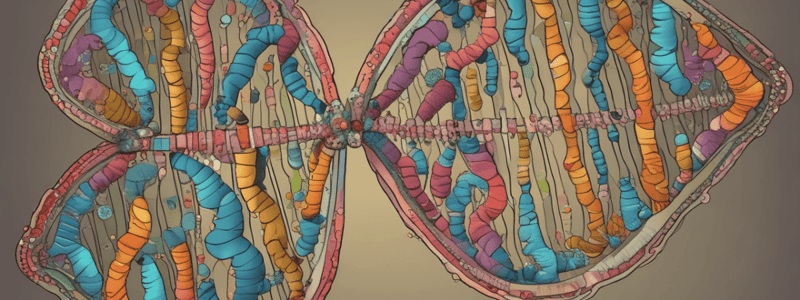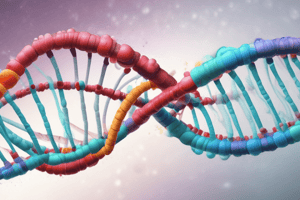Podcast
Questions and Answers
Which base does adenine (A) normally pair with?
Which base does adenine (A) normally pair with?
- Guanine (G)
- Cytosine (C)
- Adenine (A)
- Thymine (T) (correct)
What is the rare form of cytosine called?
What is the rare form of cytosine called?
- Enol
- Imino (correct)
- Ketone
- Amino
What type of mutation involves a transition from thymine (T) to cytosine (C)?
What type of mutation involves a transition from thymine (T) to cytosine (C)?
- Deletion
- Insertion
- Transition (correct)
- Transversion
The enol form of which base is not mentioned?
The enol form of which base is not mentioned?
What is an example of a disease caused by a single base mutation?
What is an example of a disease caused by a single base mutation?
What change causes the mutation that leads to sickle-cell anemia?
What change causes the mutation that leads to sickle-cell anemia?
What is the activity direction of DNA polymerase's proofreading ability?
What is the activity direction of DNA polymerase's proofreading ability?
What do eukaryotes use to label the daughter strand during DNA replication?
What do eukaryotes use to label the daughter strand during DNA replication?
Which enzyme activity is involved in initiating proofreading repair?
Which enzyme activity is involved in initiating proofreading repair?
What potential consequences can arise from uncorrected replication errors in germ cells?
What potential consequences can arise from uncorrected replication errors in germ cells?
How does DNA polymerase align the correct incoming nucleotide during nucleotide addition?
How does DNA polymerase align the correct incoming nucleotide during nucleotide addition?
What type of repair recognizes and excises newly-synthesized DNA strand mistakes?
What type of repair recognizes and excises newly-synthesized DNA strand mistakes?
Study Notes
DNA Replication and Central Dogma
- Adenine (A) pairs with Thymine (T) in normal base pairing
- Guanine (G) pairs with Cytosine (C) in normal base pairing
Alternate Base Forms and Mis-pairing
- Rare forms of bases can mis-pair due to different forms of the bases
- Imino form of cytosine and enol form of thymine can lead to mis-pairing
- Imino form of adenine and enol form of guanine can also lead to mis-pairing
Consequences of Mis-pairing
- Transition from T to C in the wild-type sequence can occur
- Single base mutation in the gluaton gene can result in a change from C to T
- Sickle-cell anemia is an example of a genetic disorder resulting from a single base mutation
DNA Repair
Base Pairing Rules
- Base pairing rules must be maintained to prevent genome mutations
- Mistakes can have consequences on daughter cells
- Only correct pairings fit in the polymerase active site
- Polymerase uses its proofreading ability to correct mistakes
- If no repair is made, problems can arise, including inherited diseases and cancer
Proofreading and Repair
- 3' to 5' Exonuclease activity of DNA polymerase I detects mis-pairing and initiates proofreading repair
- Mismatch repair recognizes mistakes and excises the newly-synthesized strand to fill in the correct pairing
DNA Repair Mechanisms
- Eukaryotes "label" the daughter strand with nicks to recognize the new strand
- Separates new from old strands to prevent errors
Studying That Suits You
Use AI to generate personalized quizzes and flashcards to suit your learning preferences.
Description
This quiz covers the basics of DNA replication, including normal base pairing and alternate forms of bases that can lead to mis-pairing.




